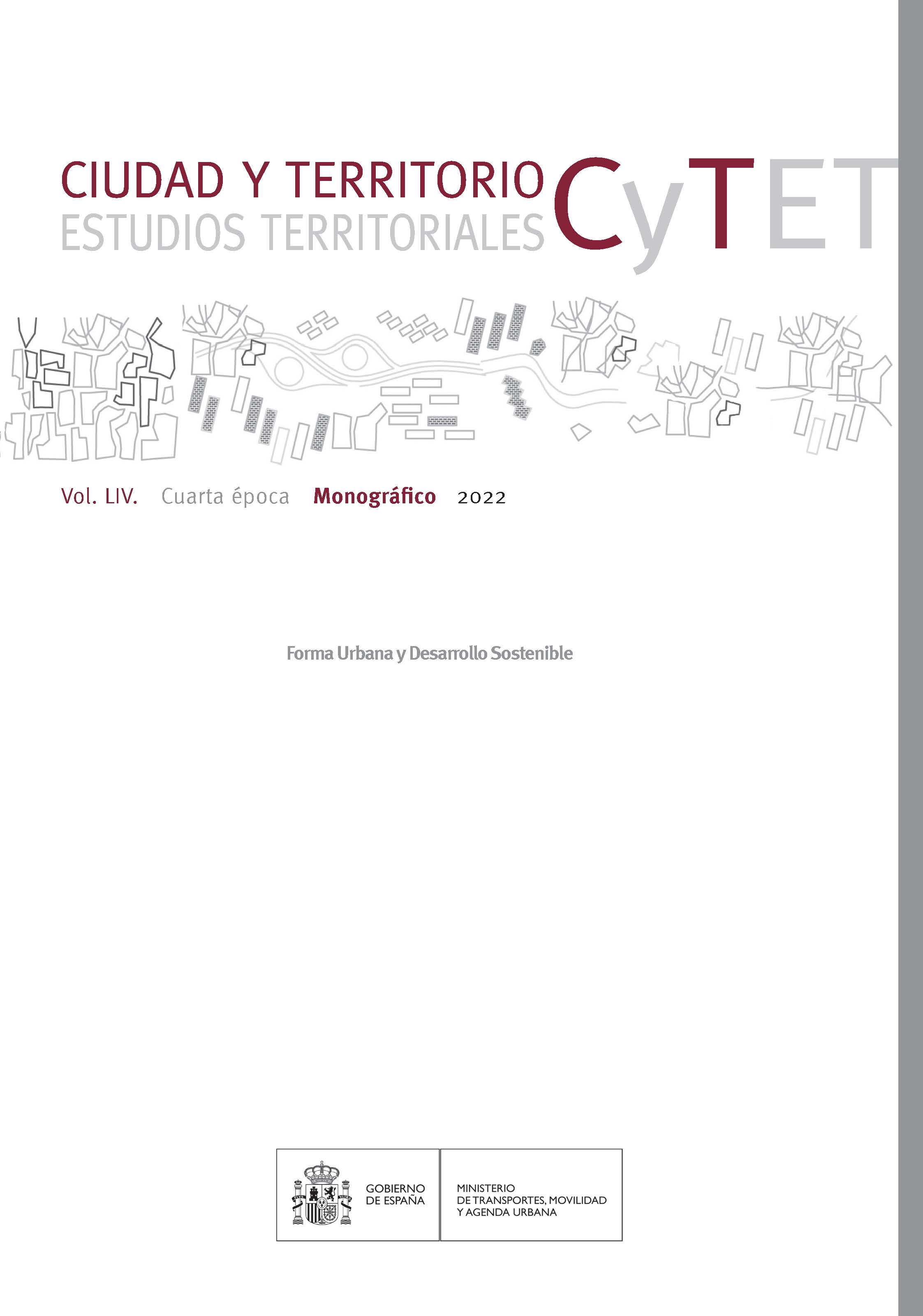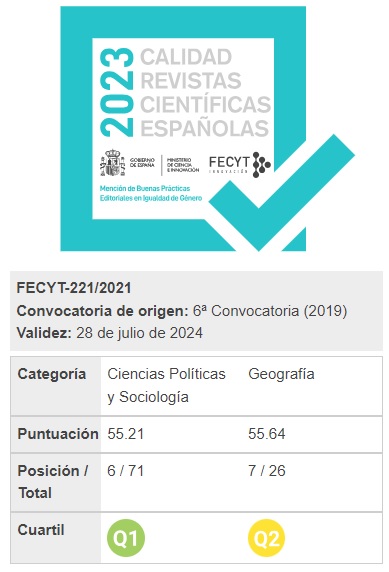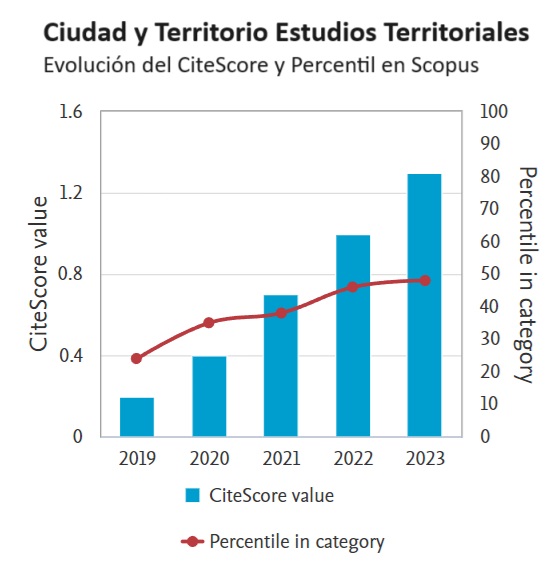Morphology of traditional landscapes in inland Spain: the potential of the rural built environment in a more sustainable future
DOI:
https://doi.org/10.37230/CyTET.2022.M22.8Keywords:
Rural environment, Landscape, Traditional morphologies, Territorial sustainability, Rural developmentAbstract
The demand for a new culture of territory confronts the sustainable project with the uncertainties of an abandoned rural environment, especially in the smaller landscapes of inland Spain, where the relationship between "countryside" and "city" should be regenerated. To what extent is the form of traditional rural landscapes an asset for the future? Overcoming both the idea of sustainability associated with an undeveloped environment, a shrinking refuge, and the patrimonial vision of a countryside without pain, an "active" reading of the territory emerges, aimed at rethinking from inside highly anthropised but declining spaces. It is here that a series of projects carried out or in progress by our research group develop an operational knowledge tool from the landscape and detect in the morphology of the built in rural spaces a potential not exclusively subjected to the interests of tourism or second homes, of urbanites at rest, but open to a global project of a more sustainable habitat.
Downloads
References
AD (2016): Designing the Rural. A Global Countryside in Flux. Architectural Design Profile, nº 242 (July-August).
Adam-Hernández, A. & Harteisen, U. (2019): A Proposed Framework for Rural Resilience. How can peripheral village communities in Europe shape change? AGER, vol. 28: 7-42.
Arendt, R. & Brabec, E. A. & Dodson, H. L. & Reid, C. & Yaro, R. D. (1994): Rural by Design: Maintaining Small Town Character, Chicago, American Planning Association.
Benito, F. (2003): La arquitectura tradicional de Castilla y León, Valladolid, Junta de Castilla y León.
Benito del Pozo, P. (2007): La ordenación de parques culturales en espacios rurales. Una propuesta para Asturias. Ciudad y Territorio Estudios Territoriales, 39 (154): 711-725.https://recyt.fecyt.es/index.php/CyTET/article/view/75803
Bielza de Ory, V. (2011): De la ordenación a la planificación territorial estratégica en el ámbito regional-comarcal, Zaragoza, Prensas de la Universidad de Zaragoza.
Bontron, J-C. (1996): Le monde rural: un concept en évolution. Revue internationale d’éducation de Sèvres, nº 10: 25-30.
Borobio Sanchiz, M. & Castillo Rodríguez, F. (2013): Guía de buenas prácticas para la intervención en los núcleos rurales, Santiago de Compostela, Xunta de Galicia.
Burgos, B. –Coord.– (2020): Pensar y hacer en el mundo rural. Prácticas culturales en contexto, Madrid, Ministerio de Cultura y Deporte.
Cabero, V. (2014): “La resistencia del campesinado y la lucha por un mundo rural vivo”. En Cortizo Álvarez, J. & Redondo Vega, J.M. & Sánchez Muñoz, M.J. (Coords.), De la geografía rural al desarrollo local: homenaje a Antonio Maya Frades (157-167), León, Universidad de León.
Calzolari, V. (2010): Paesistica-Paisaje, Valladolid, Universidad de Valladolid.
Camarero Rioja, L.A. & al. (2009): La población rural de España: de los desequilibrios a la sostenibilidad social, Barcelona, Fundación La Caixa.
Collantes, F. & Pinilla, V. (2019): ¿Lugares que no importan? La despoblación de la España rural desde 1900 hasta el presente, Zaragoza, Prensas de la Universidad de Zaragoza.
Corner, J. (2016): “The ecological imagination. Life in the city and the public realm”. En Steiner, F.R. & Thompson, G.F. & Carbonell, A. (Eds.), Nature and Cities: The Ecological Imperative in Urban Design and Planning, Cambridge (MA), Lincoln Institute of Land Policy.
De las Rivas Sanz, J.L. (2019): City turns toward Nature. Territorio, nº 88: 89-98.
De las Rivas Sanz & Fernández-Maroto, M. & Castrillo Romón, M.A. (2020): “Regeneración interior de los pequeños municipios del medio rural: innovación morfológica y activación del mercado de vivienda”. En Llop, C. & Cervera, M. & Peremiquel, F. (Eds.), IV Congreso ISUF-H: Metrópolis en recomposición: prospectivas proyectuales en el Siglo XXI: Forma urbis y territorios metropolitanos, Barcelona, 28-30 Septiembre 2020 (1-18), Barcelona, UPC-DUOT.
De las Rivas Sanz & Rodrigo González, E. & Fernández-Maroto, M. (2018): “Morfologías normativas: tácticas de ordenación en los pequeños municipios de Castilla y León”. En Monclús Fraga, J. & Díez Medina, C. (Coords.), Ciudad y formas urbanas. Perspectivas transversales (Vol. 6: Formas urbanas y territorios, 77-88), Zaragoza, Prensas Universitarias de Zaragoza.
Del Molino, S. (2016): La España vacía. Viaje por un país que nunca fue, Madrid, Turner.
EFFEKT Architects (2016): ReGen Village project, Amsterdam.
Español Echániz, I. (2006): Manual de ecología del paisaje aplicada a la planificación urbana y de infraestructuras, Madrid, Colegio de Ingenieros de Caminos, Canales y Puertos.
Esparcia, J. & Escribano, J. & Serrano, J.J. (2016): Una aproximación al enfoque del capital social y a su contribución al estudio de los procesos de desarrollo local. Investigaciones Regionales-Journal of Regional Research, vol. 34: 1-23.
EU (2018): Pueblos Inteligentes. Revitalizar los servicios rurales. European Network for Rural Development Journal, nº 26.
Forman, R.T.T. (2005): Land Mosaics. The ecology of landscapes and regions, Nueva York, Cambridge University Press.
García Fernández, E. (1986): Alfoces y pueblos de León, León, Diputación de León.
Horling, L.G. & Marsden, T.K. (2014): Exploring the ‘New Rural Paradigm’ in Europe: Eco-economic strategies as a counterforce to the global competitiveness agenda. European Urban and Regional Studies, vol 21, nº 1: 4-20.
IUU_Lab (2016a): Aplicación de la normativa urbanística de Castilla y León en los Municipios menores de 500 habitantes: criterios de ordenación urbana, Valladolid, Dirección General de Vivienda, Arquitectura y Urbanismo de la Junta de Castilla y León (inédito).
IUU_Lab (2016b): Estudio de los principios de ordenación y los instrumentos urbanísticos para la protección de la arquitectura tradicional en pequeños municipios de España, Madrid, Instituto del Patrimonio Cultural de España-Ministerio de Cultura y Deporte.
IUU_Lab 2019): Informe “Para un pueblo vivo. San Miguel del Arroyo (Valladolid)”, Valladolid, Diputación Provincial de Valladolid (inédito).
IUU_Lab (2020): Estudio del paisaje de Truchas, Grajal de Campos y Frías, Valladolid, Proyecto PUH-RePlan (inédito).
IUU_Lab (2021): Estudio de un Plan de Paisaje para Paredes de Nava (Palencia), Valladolid, Proyecto PUH-RePlan (inédito).
Jackson, J.B. (1980): The Necessity for Ruins: And Other Topics, Amherst, University of Massachusetts Press.
Jiménez Pacheco, P. (2016): Claves epistemológicas para descifrar el derecho a la ciudad de Henri Lefebvre. Estoa, vol. 5, nº 8: 21-28.
Jordán-Salinas, J. & Pérez-Eguíluz, V. & De las Rivas Sanz, J.L. (2020): Paisaje Urbano Histórico. Aprendiendo de una ciudad paisaje, Segovia. EURE, vol. 46, nº 137: 87-110.
Lalana Soto, J.L. & Pérez Gil, J. (2018): “El concepto de Paisaje Urbano Histórico como herramienta de aproximación al patrimonio urbano”. En Campos Bordona, M.D. & Pérez Gil, J. (Coords.), El conjunto histórico de Grajal de Campos (49-86), León, Universidad de León.
Lefebvre, H. (2013): La producción del espacio, Madrid, Capitán Swing (Ed. original 1974).
Linazasoro, J.I. (1978): Permanencias y arquitectura urbana: Las ciudades vascas de la época romana a la Ilustración, Barcelona, Gustavo Gili.
López Trigal, L. & Abellán García, A. & Godenau, D. (2009): Envejecimiento, despoblación y territorio: un análisis sobre la población española, León, Universidad de León-Asociación de Geográfos Españoles -Caja España.
Magnaghi, A. (1990): Il territorio dell’abitare. Lo sviluppo locale come alternativa strategica, Milán, Franco Angelli.
Magnaghi, A. –Ed.– (2000): Il Progetto locale, Turín, Bollati Bolinghieri.
Magnaghi, A. (2014): La biorégion urbaine: petit traité sur le territoire bien commun, París, Eterotopia.
Magnaghi, A. & Paloscia, R. –Eds.– (1992): Per una trasformazione ecologica degli insedamenti, Milán, Franco Angelli.
Marcuse, P. (2012): ¿Qué derecho para qué ciudad en Lefebvre? Urban, nº 2: 17-21.
Martínez de Pisón, E. (1983): Cultura y ciencia del paisaje. Agricultura y Sociedad, nº 27: 9-32.
Mata Olmo, R. (2010): “La dimensión patrimonial del paisaje. Una mirada desde los espacios rurales”. En Maderuelo, J. (Coord.), Paisaje y patrimonio (31-74), Madrid, Abada.
Mata Olmo, R. & Ferrer-Jiménez, D. (2021): La protección, gestión y mejora del paisaje en España. Estudio comparado. Ciudad y Territorio Estudios Territoriales, vol. LIII, nº 207: 189-214.
Mata Olmo, R. & Sanz Herráiz, C. –Dir.– (2003): Atlas de los paisajes de España, Madrid, Ministerio de Medio Ambiente.
Mata Olmo, R. & Tarroja, A. (2009): El paisaje y la gestión del territorio, Barcelona, Diputación de Barcelona.
Mazzucato, M. (2011): El valor de las cosas: quién produce y quién gana en la economía global, Madrid, Taurus.
Orff, K. (2016): Toward an Urban Ecology, Nueva York, The Monacelli Press.
Ortega Valcárcel, J. (2004): “La transición rural en España: el campo en la sociedad urbanizada”. En Nogués Linares, S. (Ed.), El futuro de los espacios rurales (89-114), Santander, Universidad de Cantabria.
Ostrom, E. (2000): El gobierno de los bienes comunes. La evolución de las instituciones de acción colectiva, México, Fondo de Cultura Económica.
Parra, F. (2007): La cultura del territorio: la naturaleza contra el campo. Ciudad y Territorio Estudios Territoriales, 39(151), 27-51. https://recyt.fecyt.es/index.php/CyTET/article/view/75753
Prada Llorente, E. I. (2007): Paisaje agrario: antropología de un territorio II. Ciudad y Territorio Estudios Territoriales, 39 (154), 689-709. https://recyt.fecyt.es/index.php/CyTET/article/view/75802
Prada Llorente, E. I. (2012): Guía de Buenas prácticas para la observación del paisaje agrario como espacio patrimonial en el oeste peninsular, Madrid, Ministerio de Medio Ambiente y Medio Rural y Marino.
Scott, M. & Gallent, N. & Gkartzios, M. –Ed.– (2019): The Routledge Companion to Rural Planning, Nueva York-Londres, Routledge.
Shucksmith, M. (2018): Re-imagining the rural: from rural idyll to good countryside. Journal of Rural Studies, vol. 59: 163-172.
Sociedad de los Territorialistas (2011): Manifiesto. http://www.societadeiterritorialisti.it/manifesto-sdt/
Steiner, F.R. (1991): The Living Landscape. An Ecological Approach to Landscape Planning, Nueva York, McGraw–Hill.
Tarroja, A. & Camagni, R. –coord.– (2006): Una nueva cultura del territorio. Criterios sociales y ambientales en las políticas y el gobierno del territorio, Barcelona, Diputación de Barcelona.
Published
How to Cite
Issue
Section
License
Copyright (c) 2022 Juan Luis de las Rivas-Sanz, María A. Castrillo-Romón, Miguel Fernández-Maroto, Marina Jiménez-Jiménez

This work is licensed under a Creative Commons Attribution-NonCommercial-NoDerivatives 4.0 International License.
Considering the provisions of the current legislation on Intellectual Property, and in accordance with them, all authors publishing in CyTET give -in a non-exclusive way and without time limit- to the Ministry of Transport, Mobility and Urban Agenda the rights to disseminate, reproduce, communicate and distribute in any current or future format, on paper or electronic, the original or derived version of their work under a Creative Commons Attribution-NonCommercial-NoDerivative 4.0 license International (CC BY-NC-ND 4.0), as well as to include or assign to third parties the inclusion of its content in national and international indexes, repositories and databases, with reference and recognition in any case of its authorship.
In addition, when sending the work, the author(s) declares that it is an original work in which the sources that have been used are recognized, committing to respect the scientific evidence, to no longer modify the original data and to verify or refute its hypothesis. Author(s) also declare that the essential content of the work has not been previously published nor will it be published in any other publication while it is under evaluation by CyTET; and that it has not been simultaneously sent to another journal.
Authors must sign a Transfer of Rights Form, which will be sent to them from the CyTET Secretariat once the article is accepted for publication.
With the aim of promoting the dissemination of knowledge, CyTET joins the Open Journal Access (OA) movement and delivers all of its content to various national and international indexes, repositories and databases under this protocol; therefore, the submission of a work to be published in the journal presupposes the explicit acceptance by the author of this distribution method.
Authors are encouraged to reproduce and host their work published in CyTET in institutional repositories, web pages, etc. with the intention of contributing to the improvement of the transfer of knowledge and the citation of said works.








 Enlace a CyTET en Linkedin
Enlace a CyTET en Linkedin